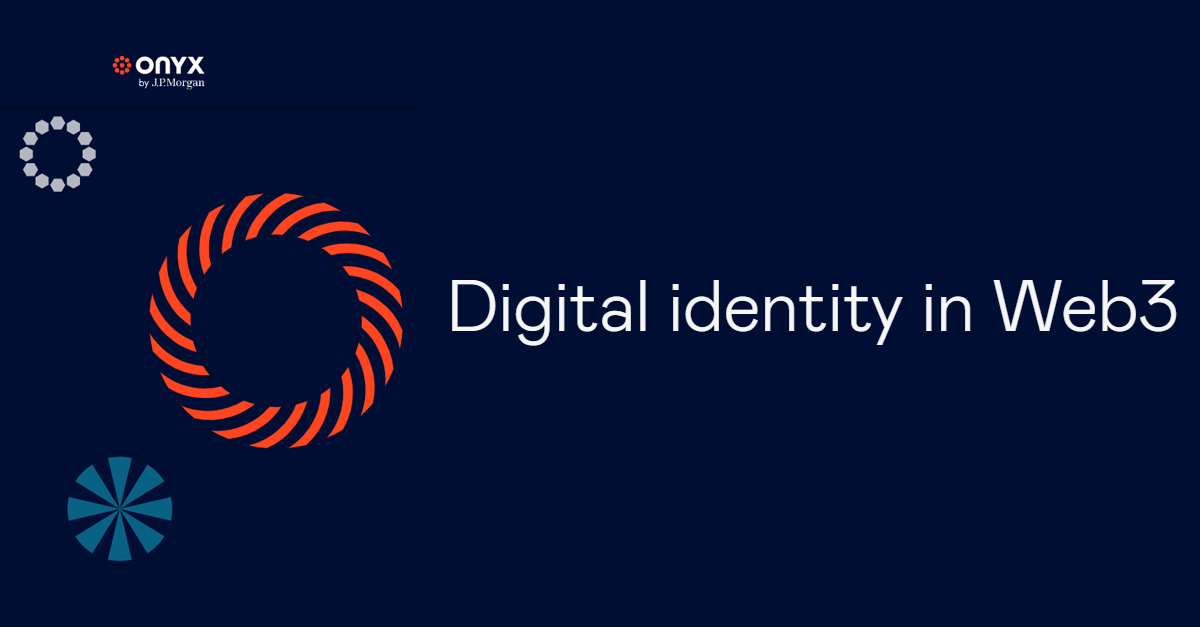
JP Morgan Onyx on Digital Identity in Web3
Let's dive in!
JP Morgan Onyx on Digital Identity in Web3
They have a video and are doing a 4-article series.
The first one - The Big Shift - was released back in 2022.
Let's see what they understand.
New web - new rules.
New verification methods that are more secure, trustworthy and easier to use.
Prior to the blockchain and even so far, the digital online world has been copying the physical world leading to many issues around identity pieces:
• unsecured communication
• inefficient and dangerous practices
• stolen identities
• much more
Web3 - introduces new possibilities.
They clearly understand how web1 changed the world through e-commerce and how web2 sparked innovation through the rise of social networks and user-generated content.
What about web3? It brings the pieces of:
Decentralized system:
• Digital ownership of your data
• Ownership of your assets
• Flips the relationship between companies and users
• Adds more cross-platform utility
• Adds provenance
• Adds immutability
That means web3 can bring another magnitude of innovation:
• Streamlining online business models (less friction for users)
• Saving time (reduce verification times)
• Making proving easier, more secure and private
• Reducing costs and unlocking more liquidity (faster and transparent public services)
For all of that to work we need to Update our Digital Identity.
That's where Decentralized Digital Identity comes with a range of benefits:
• Sovereignty (you have control and choice of your data)
• Security (no points of failure)
• Immutable and irrefutable (highly trustworthy information
While all of that sounds good, it's a very complex challenge to bring all the pieces together.
This leads us to their second article - Assessing Web3's Identity Building Blocks - was published sometime in 2023.
First of all, they are reiterating their points from the first article.
But now they are getting a bit more specific and tangible.
Starting with an overview of the digital identity landscape and highlighting 4 essential building blocks.
1. Identifiers aka everyday tags:
• Names
• Email addresses
• Accounts numbers
• Social handles
• & many more
Web3 ones are:
--- Ethereum Naming Service (ENS)
• Turns 42-character Ethereum public address into a human-readable name
• Represents multifaceted identity
• Includes a variety of blockchains
• Utilizes offchain information
• Includes website URLs (domains)
• All other identifiers
All of that is in one name!
--- Lens handle
• A user profile on the social graph of Lenster, Lenstube, etc
--- Other naming services as identifiers (Unstoppable Domains and others)
DIDs (Decentralized identifiers) are fundamental blocks of the self-sovereign identity (SSI):
• uniqueness (no confusion)
• provability (proof of ownership)
• portability (owned by an owner and cannot be deleted, cross-platform usage)
It's just a sneak peek and more is coming in the next article!
2. Identity attributes (attestations of facts or data points):
Examples:
Proof of Humanity (PoH) - Ethereum-based social identity verification system
Soulbound tokens (SBT) - public, permanent, non-transferable NFTs that can represent a person's digital identity attributes onchain.
Verifiable Credentials (VCs) - A W3C data model for sharing and verifying identity credentials that can be stored offchain allowing for privacy and scalability.
3. Reputation
It is a key part of one's identity and makes us who we are.
POAP (Proof of Attendance Protocol) is a notable example of this.
4. Digital collectibles and assets
NFTs contributing to one's identity:
• profile pictures (PFPs)
• digital art
• in-game items
• membership NFTs
• & more
Digital Identity can bring all the pieces together.
To gain scale and mass adoption, it's crucial for wallets to enable a seamless building of one's digital identity.
Account Abstraction (AA) solves some of those challenges.
Combining 4 of the essential blocks (Identifiers, Identity attributes, Reputation, and Digital collectibles & assets) with one another, can form a holistic identity.
Onyx's experience with Decentralized Digital Identity:
• observing the DID space from 2017
• identified use cases
• built concept solutions
• explored digital identity for institutions on public blockchains and experimented with VC and DID technology through a collaboration with the Monetary Authority of Singapore and SBI Digital Asset Holdings
• remain open-minded and continue exploring other methodologies for a variety of use cases
The conclusion of this article leads back to their digital identity part of the site.
They have a range of documents on other web3 and crypto-related topics.
It is obvious, that they are not thinking about Digital Identity in isolation as they are aware of nuance niches within web3 such as metaverse, DeFi, and even real-world assets.
They clearly articulate how it can be helpful for:
• online interactions (ownership, portability, security)
• creators (by moving platforms)
• gamers (asset-interoperability)
• real-world applications
In navigating the rich space of Web3, JP Morgan Onyx lays a strong emphasis on the transformative power of Decentralized Digital Identity. Their explorations highlight the potential that comes with blending digital identity with emerging tech realms like metaverse, DeFi, GameFi, SocialFi and the tangible world itself.
What else do you already see that JP Morgan Onyx still doesn't?
